Check my birding map for specific location. Coober Pedy is a town I have heard of. I know it to be the centre of opal mining and that Hamish and Andy once visited it. I wasn't sure really what to expect and was quite amazed as I drove closer to the town by the thousands of mounds of earth, between 2 and 5 metres I estimated, dotting the landscape. Every now and again there were large mine operations and there was just no doubt what the main industry is here. As I drove into town, to my surprise there were more mounds and machinery in gardens
The centre of town caused me much amusement with it's underground motels. I had recently watched the Flintstones movies and the area reminded me of Bedrock! I wondered which town was based on which. I couldn't decide whether to shop for opals or visit 'The Big Winch'. I settled for the sewage farm.
There are 2 sewage farms listed on eBird, another Coober Pedy oddity perhaps. I went to the one with the most recent listings (I couldn't find the other anyway, looked like it had been turned into a sports arena) and found the dog pound. I was sensing a pattern of weirdness in Coober Pedy. Anyway, opposite the pound was a long, thin stretch of water with lots of reeds. I could see swallows swooping along it and could hear the peep peep of dotterels so I knew it was worth a look.
I first found a white-backed Australasian Magpie. I shot it because I have only seen black-backed so far on my 2022 trip. A southern Australia anomaly? On the wire above it was a female Red-capped Robin.
Australasian Magpie (Gymorhina tibicen)
Red-capped Robin (Petroica goodenovii)
In the reeds I could hear fairywren and waited patiently for them to pop up. My luck was in as a male White-winged Fairywren sat up to sing. What an incredible bird. I had trouble processing this image because of the bright colours. I hope I have done it justice.
 White-winged Fairywren (Malurus leucopterus)
White-winged Fairywren (Malurus leucopterus)The dotterels and other birds were not very co-operative so I moved on and decided against staying in town. It was just too busy. I headed south to the Hutchison Monument which also doubles as a rest area. A very good choice as there was a huge are behind the monument and I drove around half a kilometre in till I found a spot next to some bush. I put out my portable bird bath ($1.50 courtesy of KMart) and waited. There was not a lot around other than the ever present Zebra Finches but eventually a rather shy crow (Torresian I think - no pale base feathers in the wind) circled the van and eventually came in. Often dismissed by birders and civilians alike, I think they are beautiful with that glossy plumage and bright eyes.
Torresian Crow (Corvus orru)
In the bushes were more fairywren, purple-backed this time. Again with some patience, the male came close enough to photograph. Pretty rough looking in moult but still interesting.
Purple-backed Fairywren (Malurus assimilis)
As the day wore on into late afternoon, the Singing Honeyeaters came out and were flitting around catching bugs. I don't think their call is much of a song but people don't much like my singing either!
Singing Honeyeater (Gavicalis virescens)
All in all, a very satisfactory introduction to South Australia.
eBird Lists
https://ebird.org/australia/checklist/S119124922
https://ebird.org/australia/checklist/S119121137


























































